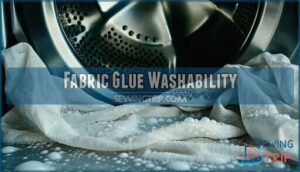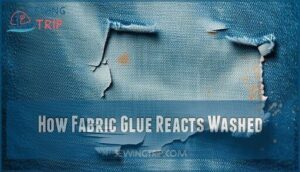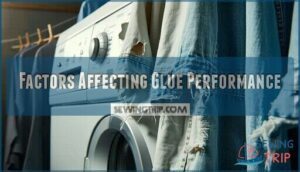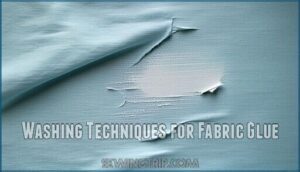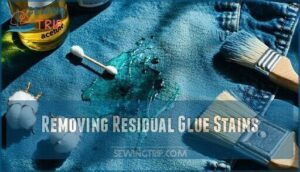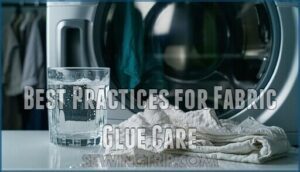This site is supported by our readers. We may earn a commission, at no cost to you, if you purchase through links.
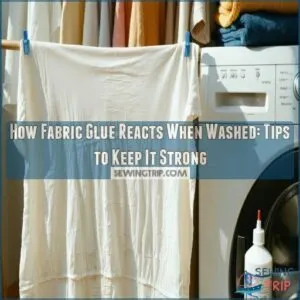
Most fabric glues are washable, but they’ll lose their grip if exposed to high temperatures, harsh detergents, or rough wash cycles.
Cold water and gentle cycles are your best friends here. Some glues might stiffen fabrics slightly or cause discoloration, so testing a small area first helps.
Over time, frequent washing can weaken the adhesive, much like how tape peels after too much handling. To keep things strong, air-drying is ideal—heat weakens bonds.
The right glue and care combo go a long way in keeping things intact!
Table Of Contents
- Key Takeaways
- Fabric Glue Washability
- How Fabric Glue Reacts Washed
- Factors Affecting Glue Performance
- Washing Techniques for Fabric Glue
- Removing Residual Glue Stains
- Maximizing Adhesive Durability
- Common Challenges and Solutions
- Best Practices for Fabric Glue Care
- Frequently Asked Questions (FAQs)
- Conclusion
Key Takeaways
- Stick to cold water and gentle cycles to prevent glue weakening or fabric damage.
- Always air-dry glued items; heat from dryers can weaken the bond or cause discoloration.
- Test glue on a hidden area first to check for discoloration or texture changes after washing.
- Avoid using harsh detergents or fabric softeners; they can degrade the adhesive over time.
Fabric Glue Washability
When you wash items with fabric glue, its adhesion and appearance can change depending on the conditions.
Understanding how glue reacts to water, detergent, and drying can help you keep your projects looking their best.
Effects on Adhesion Strength
Understanding fabric glue’s adhesive strength is essential.
While initial bond strength guarantees a solid hold, frequent wash cycles and high temperatures can weaken water resistance.
Harsh detergents may cause glue failure, reducing long-term durability.
To maintain bond integrity, stick to cooler washes and gentle detergents.
Proper care makes a difference—glue durability doesn’t improve if you ignore clear instructions! It is crucial to follow the guidelines for long-term durability.
Changes in Fabric Appearance
Fabric glue can noticeably change how fabric looks.
Fabric glue transforms fabric’s appearance, adding strength but altering texture and color—balance creativity with care for flawless results.
You might see:
- Color alteration: Glue may darken colors, creating uneven patches.
- Texture changes: Cured glue can stiffen soft fabrics.
- Shrinkage effects: Some fabrics feel tighter around glue.
- Glue visibility: Residue might seep through fabric, reducing appeal.
Proper wash techniques help minimize these effects and maintain glue durability.
Residual Odor After Washing
Leftover glue residue from washing can trap odors, making items smell unpleasant over time.
Odor causes often stem from unwashed glue spots absorbing detergents or moisture. Use scented detergents for odor elimination, but verify they won’t harm the fabric.
For odor prevention, wash with cold water and fully dry. Long-term smell issues? Try adhesive removal techniques like pre-soaking glue-stained areas.
Potential Discoloration of Fabric
Glue yellowing or color bleeding can sometimes cause stain visibility after washing, especially on lighter fabrics.
Fabric degradation or texture changes might occur if the glue reacts poorly with water or detergent.
To avoid permanent glue stains or damage, focus on proper fabric care. Test on hidden areas first, as glue residue can make stain removal a tricky process.
How Fabric Glue Reacts Washed
When fabric glue meets the washer, things get interesting.
Washing can weaken bond integrity, impacting how well the glue holds up over time. While some adhesives boast resistance, a few cycles might still break them down.
Here’s how washing affects it:
- Glue Degradation: Repeated washing can soften or weaken the glue over time, especially in high heat.
- Adhesive Residue: Glue may leave faint stains or residue on certain fabrics, frustrating to remove.
- Washing Impact: Water temperature and detergent choices play roles in glue longevity.
- Bond Failure: Excessive or rough washing risks loosening glued areas entirely.
- Stain Removal Challenges: Once glue cures, removing stains becomes a skillful battle.
Treat adhesive projects carefully to guarantee their longevity. Wash gently for best results!
Factors Affecting Glue Performance
You’ll notice fabric glue’s performance depends on more than just the brand—it’s all in the details.
Factors like the fabric type, washing habits, and even how you dry your items can make or break its durability.
Fabric Type and Texture
The weave of a fabric can affect how well glue absorbs and stays put.
Smooth, dense textures limit absorption, while coarse or open weaves may hold adhesives better but risk uneven bonds.
Fiber sensitivity plays a role, too—delicate fabrics could need extra surface prep.
Always check your glue’s compatibility with the material before tossing it in the washing machine, considering the absorption.
Water Temperature and Detergent Used
Choosing the right water temperature and detergent prevents glue degradation and color fading.
Hot water can break adhesion, while cold water preserves strength.
Detergent types matter too—enzyme-based ones excel in cold cycles.
- Use cold water for longer glue life.
- Avoid hot water stains set faster.
- Test detergents beforehand.
- Gentle wash cycles reduce damage.
- Skip fabric softeners; they weaken bonds.
Many fabrics benefit from gentle wash cycles to maintain their integrity, using cold water and avoiding hot water can be beneficial, and following these tips can lead to a longer glue life.
Frequency of Washing
Frequent washing shortens the lifespan of glued fabrics.
Over time, improper washing habits lead to glue degradation, reducing wash durability.
Stick to washing instructions for ideal frequency—think every three to five wears to minimize damage.
Use gentle cycles on your washing machine, as aggressive wash cycles can strain adhesion.
These laundry guidelines preserve garment lifespan and overall fabric maintenance.
Drying Methods and Conditions
Regarding drying fabric glue, drying time and conditions truly matter.
Follow these tips:
- Avoid high heat—it can weaken adhesion.
- Opt for air drying in a space with good air circulation.
- Keep the humidity low to guarantee proper curing.
- Never expose adhesive to direct sunlight; it may affect the bond’s durability.
Washing Techniques for Fabric Glue
When washing fabrics bonded with glue, you’ll need to balance gentle handling with thorough cleaning to keep the adhesion strong.
Avoid hot water, harsh detergents, or heavy agitation, as they can weaken the bond and damage your project, requiring careful handling to maintain the bond.
Suitable Washing Methods
Stick with gentle cycles or hand washing to keep fabric glue intact.
Spot cleaning is your best friend for minor stains—save heavy scrubbing for your sneakers! Use a mild detergent choice to avoid weakening the bond.
Using a mild detergent fabric is essential for maintaining the glue’s integrity.
Avoid hot water or harsh laundry tips, as these can compromise adhesion.
Smart washing techniques make clothing care tips simple and effective.
Precautions to Preserve Adhesion
To keep fabric glue intact, handle glued items with care.
Use these washing tips for better adhesive properties:
- Gentle settings: Stick with cold water and mild cycles to protect the bond.
- Air drying: Skip the dryer; heat weakens glue’s hold.
- Avoid overload: Crowding machines damages glue application and fabric preservation.
These steps preserve your fabric glue’s strength through every wash.
If removal is needed, consider solvent-based glue solutions.
Avoiding Harsh Chemicals or Processes
Skip harsh chemicals to protect your fabric glue’s bond.
Gentle alternatives like dish soap or a vinegar solution work well for cleaning.
Stick to cold water and the gentle cycle to avoid stress on the adhesive.
For tough spots, try enzyme cleaners or mechanical removal methods like scraping.
Natural solvents help with glue removal without damaging fabrics.
Removing Residual Glue Stains
Removing stubborn glue stains after washing can feel like an uphill battle, but it’s not impossible with the right approach.
By using targeted techniques like acetone or alcohol, you’ll be able to tackle those pesky spots and restore your fabric’s clean look.
Reattaching Loose Areas After Washing
Revive adhesion after washing by reactivating the glue using a warm iron or applying fabric glue directly to loose edges.
Focus on securing edges to prevent fraying, and use reinforcement techniques like pressing the bond firmly.
For stubborn spots, clean glue residue first with proper glue removal techniques before reapplication.
Consider using specialized products for reattaching fabric to guarantee a lasting bond.
These re-application methods guarantee a stronger hold for washed fabric.
Repairing Damaged Adhesion Post-Wash
After washing, repairing damaged adhesion can feel tricky, but it’s doable.
Start by clearing residue and prepping washed fabric for glue reactivation.
Use:
- Glue reactivation: Apply heat (if compatible) or re-glue edges.
- Reinforcement methods: Add extra adhesive.
- Edge fraying fixes: Trim loose fibers.
- Preventative measures: Let glue cure fully next time.
- Laundry solutions: Switch to gentle cycles.
For advanced techniques, consider exploring glue reactivation products.
Preventing Future Detachment in Wash Cycles
To prevent glue detachment during washing, follow these tips.
Allow washable glue to cure fully—typically 3-7 days.
Opt for gentle wash cycles and cold water for fabrics with a permanent bond.
Reinforce edges with precise glue application techniques if wear is likely.
For fragile textiles, consider fabric reinforcement methods.
Comparing glue brands helps guarantee long-term adherence under wash cycle optimization and ensures long-term adherence.
Maximizing Adhesive Durability
You want your fabric glue to withstand repeated washes without losing its strength, and a few smart steps can make all the difference.
By paying attention to the washing process and using proper care, you’ll keep your projects intact longer.
Pay attention to washing techniques and care to preserve fabric glue strength and keep your projects looking their best.
Expert Tips for Long-Lasting Adhesion
Always prep surfaces by cleaning and drying; dirt sabotages a permanent bond.
Apply fabric glue evenly for better adhesion. Let curing time do its thing—rushing won’t help.
Use gentle but firm pressure techniques to set the glue. Check material compatibility, as not all fabric adhesives are machine washable.
Reactivate adhesive with heat if needed, but test first to ensure a strong and lasting bond.
Strategies for Prolonging Adhesive Lifespan
Start strong with proper application—spread fabric glue evenly and press firmly.
Choose the right glue for your project; not all are machine washable.
Clean and dry your fabric before use.
Store glue tightly sealed, away from heat or moisture.
Allow full curing time before washing to avoid glue stains or adhesive reactivation.
For enhanced adhesion, consider pre-washing fabrics.
Small steps, big lifespan!
This is a critical step to ensure the glue works as expected, and following these steps can lead to a strong bond.
Sustainable Practices for Washing Fabric Glue-Adhered Items
Stick to eco-friendly detergents and minimize water usage with a minimalist washing routine.
Use cold water to boost water conservation while preserving adhesion. Skip harsh processes—opt for energy-efficient drying methods instead.
Biodegradable glues make stain removal easier, but handle glue stains promptly using laundry hacks like spot-treating. Sustainable care keeps glue strong and your fabric projects looking fresh!
Common Challenges and Solutions
Washing fabric glue can lead to peeling edges, discoloration, or weakened adhesion if you’re not careful.
Knowing how to tackle these issues makes all the difference in keeping your projects intact.
Addressing Issues With Washed Fabric Glue Applications
Glue residue after washing can cause frustration, but it’s fixable. Notice bond failure or adhesive stains?
A little care goes a long way:
- Test washing alternatives like gentle cycles.
- Treat fabric damage with spot cleaning before machine washing.
- Combat glue stains by freezing and scraping off excess dry glue.
- Avoid color bleeding—always test solvents on hidden areas first.
Comparison of Different Fabric Glues Post-Wash
When comparing fabric adhesives post-wash, it’s clear not all glues perform equally.
For instance, Aleene’s washable adhesive offers impressive wash durability, but residue or slight discoloration may appear on sensitive fabrics.
Textile glues like Beacon Fabri-Tac resist fabric damage and maintain permanent bonding, while others risk adhesion loss.
Check for color change—your washable adhesive should enhance, not embarrass, your creativity.
Recommendations From Manufacturers
Manufacturers know fabric glue can be tricky, especially after washing.
To keep your projects intact, follow their advice:
- Test glue on fabric for compatibility.
- Use curing times as instructed.
- Apply adhesive evenly, avoiding oversaturation.
- Store glue in a cool, dry spot.
- Choose recommended adhesives built for washing sturdiness.
Their guidance minimizes glue stains and guarantees long-lasting results!
Best Practices for Fabric Glue Care
To keep your fabric glue strong through wash cycles, you’ll need to focus on proper care and handling.
From washing techniques to drying tips, a little attention goes a long way in preserving its hold.
Industry Insights and Expert Recommendations
Professionals stress using acetone-based solvent solutions as a fast remedy for glue cleanup.
Fixing framing mistakes or removing glue stains? Always test small areas first.
Conservator advice recommends tackling washing issues delicately to avoid further damage. For glue longevity, follow label instructions and avoid shortcuts.
Practical stain removal methods go a long way in saving your projects—and your sanity!
Tips for Maintaining Glue Integrity
To keep your glue projects intact, apply it evenly and follow drying times. Choose fabrics suited for strong adhesion. Don’t over-wash; frequent washing weakens bonds.
- Store glued items properly—avoiding damp places.
- Use gentle detergents; harsh chemicals can degrade glue.
- Handle with care during washing to prevent glue stains or damage.
To maintain fabric quality, consider gentle washing techniques. Proper application and thoughtful care make a difference! For the best results, ensure you are using the right methods for your specific needs, and always prioritize gentle washing.
Ensuring Proper Drying Post-Wash
After washing, focus on proper drying to keep your fabric glue intact.
Opt for airdrying with good air circulation to avoid heat damage. Skip the dryer, as high heat can weaken adhesive drying and set stains.
Lay items flat to prevent wrinkles and maintain shape retention. Gentle care guarantees your project stays strong and ready for its next adventure, with proper handling ensuring longevity.
Frequently Asked Questions (FAQs)
Does fabric glue survive washing?
Imagine glue as a stubborn friend—once cured, fabric glue clings tight and shrugs off most washes, including hot cycles.
Its water-based magic holds strong, making it perfect for bonds that withstand repeated laundering.
How to wash out fabric glue?
Start by scraping off excess glue.
For dried spots, use acetone (like nail polish remover) on a cotton swab, dabbing gently.
Rinse thoroughly, then wash with detergent. Repeat if needed; patience is key!
Will glue come off in the wash?
Fabric glue won’t come off easily in the wash after it cures.
It’s designed to stay put, even through hot water cycles.
For removal, you’ll need solvents like acetone, not just soap and water.
Will fabric glue dissolve in water?
You know, water’s no match for cured fabric glue.
Once it dries, it’s like a stubborn houseguest—sticking around no matter how many washes you throw at it.
Heat can sometimes soften it, but don’t bank on it, as cured fabric glue is quite resilient.
Is it possible to remove fabric glue from clothing after washing, and if so, how?
You can remove fabric glue after washing, but it’s tricky.
Try acetone or nail polish remover on a hidden spot first.
Dab the glue carefully, scrape gently, and repeat as needed.
Patience is key!
Does fabric glue weaken under prolonged sun exposure?
Extended sun exposure can weaken fabric glue over time, especially if it’s not UV-resistant.
The heat and UV rays can break down the adhesive’s bond, so keep your projects shaded to guarantee durability.
How does fabric glue handle high humidity levels?
Imagine humidity as a glue’s kryptonite.
High humidity doesn’t weaken fabric glue itself, but it can slow down curing, leave it tacky, or impact long-term hold, especially if the bond wasn’t fully dry initially.
Are specific detergents harmful to fabric glue bonds?
Some detergents, especially those with strong enzymes or harsh chemicals, can weaken fabric glue bonds over time.
Stick to mild, non-bleach detergents for better longevity.
Always check the glue’s instructions for washing recommendations!
Does washing affect the flexibility of glued fabric?
Washing glued fabric usually won’t affect its flexibility if the glue’s designed for fabrics, like Aleene’s OK to Wash-It.
It creates a flexible bond that moves with the fabric, even after multiple washes.
Conclusion
Washing fabric glue-adhered items is a balancing act—treat it gently, and it holds strong; ignore care tips, and adhesion falters.
Knowing how fabric glue reacts when washed helps you preserve its bond.
Stick to cold water, gentle cycles, and avoid heat like it’s the enemy.
Test for discoloration or stiffness beforehand, and always air-dry for lasting results.
With the right precautions, your projects stay intact, even through frequent washes, and handle it right, and the glue does the rest!

